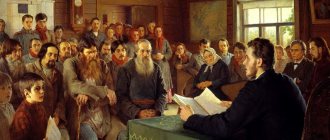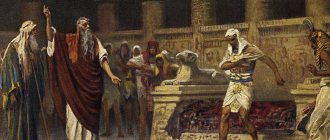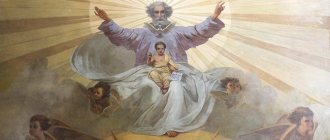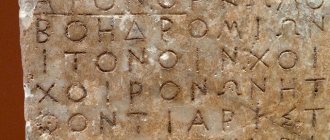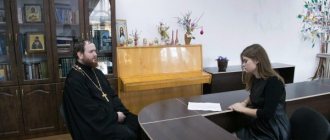Kohanim - priests in the Temple
Coens
(
kohanim
,
kohanim
,
Hebrew:
כֹּהֵן) - Jewish priests, descendants of the High Priest Aaron, who served in the portable Tabernacle of the Covenant - the Mishkan in the desert, and then in the Jerusalem Temple.
The word “ kohen”
appears several times in the Pentateuch in the meaning of “priest”, “priest,” but subsequently this term was assigned specifically to Jewish clergy from the family of Aaron, chosen by G-d as a priest-kohen. Currently, many descendants of the Kohanim bear the surnames Cohen, Kogan, Kagan, Katz.
Literal translation of the word kohen
into Russian, as it was said, a priest who participates in the G-service taking place in the Temple (see commentary by Rashi on Bereshit 47:22, Ibn Ezra on Bereshit 41:44).
This word is used in the Tanakh not only when talking about Jewish priests who serve the one Creator, but also when talking about non-Jews - priests who serve various pagan deities. So, for example, in the Miketz section Poti Fera kohen On is mentioned, in the Vaigash section the Egyptian priests are called kohanim
, and in the Shemot Itro section they are called “Kohen Midian.”
Descendants of the High Priest Aaron bless the people with the “Blessing of the Kohen”
The Jewish priests are the paternal descendants of Aaron. Most elements of Temple service are only "valid" if they are carried out by kohanim
.
In addition to working in the Temple, for the kohanim
charged with showing the people the right path (see, for example, Devarim 17:9).
Since the kohanim
called to be closer to the Creator, they have a number of duties (commandments) prescribed only to them. The commandments they fulfill help them achieve closeness to the Creator.
However, the Rambam says (Laws of Shemita ve-Yovel 13:13) that every Jew is given the opportunity to become like a Kohen
. I quote the words of Rambam:
«And not only the tribe of Levi, but also any person who comes into this world, whose spirit moved him and his consciousness managed to separate himself in order to stand before the Most High, and serve Him, and be in His service, to know the Most High; [if he] followed the straight path, as the Most High created it, and threw off from his neck the yoke of many calculations that people [usually] engage in, such a person is sanctified, and becomes the Holy of Holies, and the Most High will be his share and inheritance forever and ever forever and ever, and will give him enough in this world, just as He gave to the Kohanim and Levites. After all, David, peace be upon him, says: “The Lord is my portion and my cup (destiny), You make my destiny successful.”
».
In conclusion, we would like to quote excerpts from an article (translated into Russian) by Rav Zamir Cohen about an interesting study related to the kohanim
:
“70-80% of them are carriers of a common gene, which is not found with such frequency in any other group of the population. Jews who are not Kohanim
, and non-Jews are carriers of this gene in only 5% of cases.
The presence of this gene indicates that the Kohanim
are members of the same family, descendants of the same person.
Anyone who has read the Torah knows that their ancestor is Aaron HaKohen. All his children, and all his sons' sons, and all their sons' sons, etc. — kohanim
.
Aaron and his descendants were chosen by the Most High to teach the Torah to the people of Israel and to serve in the Temple of the Most High on behalf of all the people. And today they bless those who pray with the “Blessing of the Kohanim.”
The study was carried out by Dr Goldstein of Oxford and Dr H. Ben-Ami of the Rambam Hospital in Haifa. The project leader in Israel is Professor Karl Skorecki, head of the department of molecular nephrology at Beit Sefer li-Refua. The results of the study, published in NATURE, confirm what we know from the Torah about the lineage of the Kohanim
and about the inheritance
of keuna
from generation to generation only through the male line.
The children of a kohanim's
whose husband is not
a kohanim
are also not
kohanim
.
Indeed, the children of the daughters of the Kohanim
this gene has not been found.
The reason is simple: it is found only on the male Y chromosome. The son receives the male chromosome only from his father and passes it on only to his sons. And the grandchildren of a kohanim
receive this gene from their father, indicating that they belong to the
kohanim
.
The law of the Torah finds its expression in the DNA contained in all cells of the body of the kohen
, the bearer of the genetic seal.
Coens
- members of all communities of the Jewish Diaspora - are marked with the seal
of keuna
. This was only recently discovered by genetics.
But that is not all. Genetics knows that when passed on to the next generation, this gene undergoes minor changes. These changes are observable, so it is possible to establish, in accordance with the magnitude of the change, how many generations have passed from the ancestor, the carrier of the gene in its original form. Anyone who knows the Torah does not, of course, need any research to say that the ancestor of the Kohanim
is Aaron HaCohen, who was 83 years old when leaving Egypt, brother of Moshe Rabbeinu (Moses).
Kohanim dressed in an ephod - a special breastplate with 12 stones
It will be interesting to see whether geneticists will come to the same conclusion. And so, the study showed that on average, from the ancestor of the kohanim
until today there have been 106 generations.
To “get” to the ancestor, one must multiply this number by another, expressing the “life expectancy” of one generation. Of course, this number cannot be the same for all cases, because one Kohen
may be born, for example, to a twenty-year-old father, and another to a forty-year-old father. It is accepted that “one generation” is, on average, 30 years. Multiplying 30 by 106 gives 3160 years; and the Jews left Egypt about 3,300 years ago. The results of the calculations (on average) almost completely coincide with what we know about the years of Aaron’s life from the Torah.
Anyone who refuses to recognize the authenticity of the tradition of the people of Israel can only bow his head before the arguments of science: the tradition of the Torah, passed on from generation to generation, is reliable and true.”
Page 1 of 2
JUDIAN CRIESTS - a special group of persons specifically engaged in the performance of duties related to the practice of the Jewish religious cult. In ancient times, the most important religious activity among Jews was sacrifice, which was entrusted to the clergy. Initially, these responsibilities were assigned to the firstborn of all generations of the sons of Israel, but after the Exodus from Egypt they passed to the descendants of the tribe of Levi, to which the brothers Moses and Aaron belonged. Later, the clan of Aaron acquires special significance, which, despite the protests of some of the people, acquires primary importance. Only the Aaronids have the right to serve at the altar and receive for this service a certain share of the sacrifices, as well as a tax on the fruits of the earth received by the parishioners. They were called kohanim (cohens). The remaining priests (Levites) had to perform other temple services. Other Jews were generally prohibited from entering the sanctuary where sacrifices were made. During the period of the united kingdom of David and Solomon, this principle was not always observed, and often the functions of priests were performed by persons of non-priestly rank, in particular David himself. After the collapse of the unified state in the Northern Kingdom (Israel), the Aaronid status was not recognized, but in the Southern Kingdom (Judea), in whose capital the Jerusalem Temple was located, it was, as a rule, supported. It became especially firmly entrenched after the reforms of the Jewish king Josiah, when all worship was concentrated in the Jerusalem Temple. It was then that the tradition of the primacy of the high priest, the zadok, serving in the temple under King Solomon, was established. He was recognized as a direct descendant of Aaron, and his position was inherited. The high priest was supposed to be superior to all priests in his knowledge, physical strength and wisdom. Only the high priest could perform worship at his own discretion and spent most of his time in the Temple. He had to be married to a virgin, and polygamy was excluded. In addition to the usual priestly attire, he wore special clothes, richly decorated with gold and precious stones, and a special headdress like a tiara. Ordination to the high priesthood took place by putting on the high priestly garment seven times over the course of seven days. Anointing with oil was also practiced. Much of this was later borrowed by Christians. After the return of the Jews from the Babylonian captivity and the restoration of the Temple, the position and regulation of the duties of the Aaronids and Levites were finally consolidated. The former were responsible for sacrifices, and the latter performed the duties of singers, temple servants and guards. The dynastic genealogical records of the Jewish clergy were kept and preserved very strictly, and special requirements were placed on their wives. Marriage with divorced women or those descended from parents whose marriage was not recognized as legal was categorically excluded. Temple clergy were not supposed to have physical disabilities, a list of which was carefully developed. When performing temple duties, clergy were not supposed to drink wine, and they were forbidden to touch corpses. The tribe of Levi was not entitled to any land allotment at all, and they had to live off a share of the sacrifices. In addition, every Jew was obliged to give the first fruits of agriculture and cattle breeding to the Temple.
<< First < Previous 1 Next > Last >>
In the Old Testament - priests. In the New - ministers: bishops, presbyters, deacons
The Old Testament Hebrew word kohen - “priest” comes from the verb kohan - “to be sacred,” “to perform sacred service,” that is, to make a sacrifice and perform service in the temple. The priests at the Old Testament temple (tabernacle, sanctuary) were representatives of the family of Aaron, the first High Priest from the tribe of Levi (see Exodus 29:9, Exodus 40:13-15). Israelites from other families of the tribe of Levi, the so-called Levites, helped carry out auxiliary functions for the Aaronides in serving at the tabernacle (see Num. 3:5-10, Num. 18:1-4, 1 Chr. 23:27-32).
The New Testament lists Christian ministers (see 1 Tim. 3:2,8, Acts 14:23): bishop, Greek. επίσκοπος – overseer; presbyter, Greek πρεσβύτερος – elder, head of the community; deacon, Greek διάκονος - servant. At the same time, the New Testament never calls them priests, because with the death of Jesus the need to serve in the temple disappeared. It is worth noting that in the Russian Synodal Translation of the New Testament, the term “priesthood” was still erroneously used in relation to church leaders:
“Do not neglect the gift that is in you, which was given to you by prophecy with the laying on of the hands of the priesthood ” (1 Tim. 4:14).
However, in the original Greek text, instead of the word “priesthood” there is “presbytery” - “πρεσβύτερου”.
Previously, through the priests, the sin of the people entered the sanctuary. That is, priests were intermediaries between God and people. Jesus fulfilled the ritual part of the Law of Moses, becoming both sacrifice and priest. As a substitutionary sacrifice, He atoned for our sins with His blood (see Eph. 1:7, Heb. 9:12, 1 John 1:7, Rom. 3:24, 1 Cor. 6:20). And as a priest, Christ became true tabernacle in heaven (see Heb. 8:1,2) - henceforth the only mediator between people and God the Father. And this priesthood began on Calvary, when Jesus was a man:
"There is one God, one mediator between God and men , the man Christ Jesus"
……who gave himself as a ransom for all. Such was the testimony at one time for which I was appointed a preacher and an Apostle - I speak the truth in Christ, I do not lie - a teacher of the pagans in faith and truth. (1 Tim. 2:7).
Therefore, when today we hear that in order to turn to God for the forgiveness of sins, intermediaries in the form of priests are needed, we need to know that this statement has no biblical basis. The New Testament never talks about this. The minister can only act as a witness to the confession of the sin of the repentant person to God.
However, the priesthood did not disappear completely from the New Testament. In the Old Testament, God did not only call the ministers of the tabernacle priests. One of the purposes of the priesthood was to teach the people the laws of God (see Lev. 10:11, Mal. 2:7, Neh. 8:7, Deut. 24:8, Deut. 31:9-12, Ezek. 44:23) . Therefore, during the conclusion of the covenant with the Jews, the Lord called all a priesthood in relation to the Gentiles: “You will be to Me a kingdom of priests ... an inheritance from all nations” (Ex. 19: 6,5). So, in the light of the Gospel message, the Apostle Peter all a royal priesthood in relation to unbelievers : “You are a chosen generation, a royal priesthood ... a people taken for his own possession , that proclaim the praises of Him who called you” (1 Pet. 2:9, see also 1 Pet. 2:5).
Compare these statements about Christians and Jews. Isn’t it clear that they contain one idea? Both under the Old Testament and under the New, the Creator wants the people He has chosen to show all nations the Glory of the Great One Living God (see 1 Chron. 16:24). Look what the Apostle Paul says about this: “To be a minister of Jesus Christ among the Gentiles and to minister the gospel of God” (Rom. 15:16).
Thus, in the New Testament there are no longer priests - ministers of the temple, since the Old Testament temple service was fulfilled in Jesus, but the priesthood remained in the form of all Christians, bringing the sacred gospel of God to the world.
The Blessing of Personal Dialogue
To the table of contents “Articles for the weekly portions of the Torah”
Torah Commentary Book Bemidbar Weekly Section Naso Chapters 4-7
Pinchas Polonsky
1. Three levels of blessing of kohens 2. In Judaism, a priest cannot be a “mediator” 3. It is necessary to address the Almighty personally 4. The blessing of priests helps to enter into a personal dialogue
[1. Three levels of Kohen blessing]The weekly portion of the Torah for this Shabbat says that the priests - “kohens”, descendants of Aaron - should bless the Jews with the following words: “May the Lord increase what belongs to you and protect you. May the Lord illuminate you with His Face and show you mercy. May the Lord turn His Face towards you and give you peace” (Bamidbar 6:24). We see here three levels of blessing, corresponding to the three levels of human existence: material, mental and spiritual.
On the first level - material - the blessing is that a person’s property, his health, everything he owns, increases and is preserved. However, a person needs all this not in itself, but for the transition to the next level - the mental one. Blessing at this level consists in “illumination of the soul”, in the fact that the human soul is illuminated by Divine light. And here “Divine grace” is necessary, because a person’s sins spoil his soul, and the mercy of the Almighty is expressed in the fact that less damage is caused to the soul. However, this level is not an end in itself, and the blessing moves to the third level, the spiritual, the essence of which is the personal contact of a Jew with the Almighty. Here, every Jew is blessed so that the Lord turns His Face to him, and he is able to enter into personal direct contact with God.
[2. In Judaism, a priest cannot be a “mediator”]
In this regard, we can also understand the role of the priest who conveys these blessings to the Jews. The priest is called to help the Jew make sacrifices in the Temple; sometimes he says prayers on behalf of the entire people, he conveys Divine blessing to a person. But it does not happen that a Jew turns his prayer to a priest so that he can convey it to God. Unlike some other religions, in Judaism the priest is never the authority to which a person turns - for example, for the forgiveness of his sins or as a “mediator” when turning to the Almighty. Such treatment is completely prohibited. This difference is clearly manifested, in particular, in the different approaches of Judaism and Christianity to the concept of confession, i.e. confessing your sins to God. Judaism places great importance on confession; however, a Jew does not need a priest or any other person for confession - every Jew should confess only directly to the Almighty.
[3. It is necessary to contact the Almighty personally]
It happens that people who define themselves as non-religious, but have come to an internal need to turn to the Almighty, turn to the religious: “Well, you are closer to God, pray for us.” This approach is completely inconsistent with the spirit of Judaism. A person should not think that because he is weak or sinful or “irreligious” that someone else “more righteous” will be better able to pray to God for him. On the contrary, the most powerful thing is the personal prayer of the person who is directly affected by the problem.
[4. The blessing of priests helps to enter into personal dialogue]
What helps a Jew to enter into a personal dialogue with the Almighty is the blessing that God gives him through the priests, so that his material and mental level can serve as the basis for ascending to the spiritual level. This blessing ends with the words, “and (God) will give you peace.” The word “peace” - “shalom” in Hebrew means not only “absence of war”, but also “integrity”, “completeness”, “harmony”. This integrity is achieved when all three levels of a person’s existence act not on their own, but as elements of his connection with God. And thanks to this, a person finds true peace.
